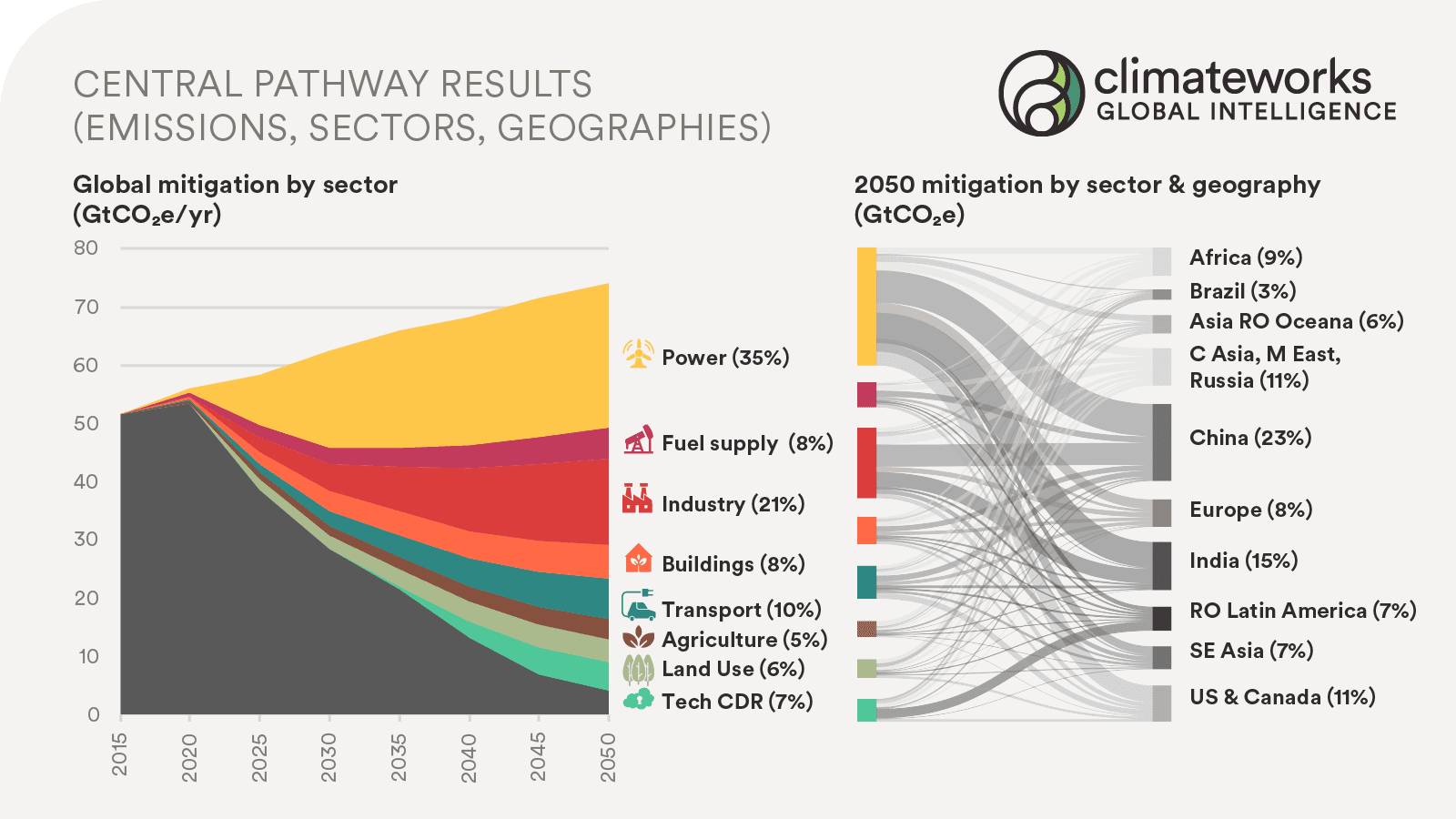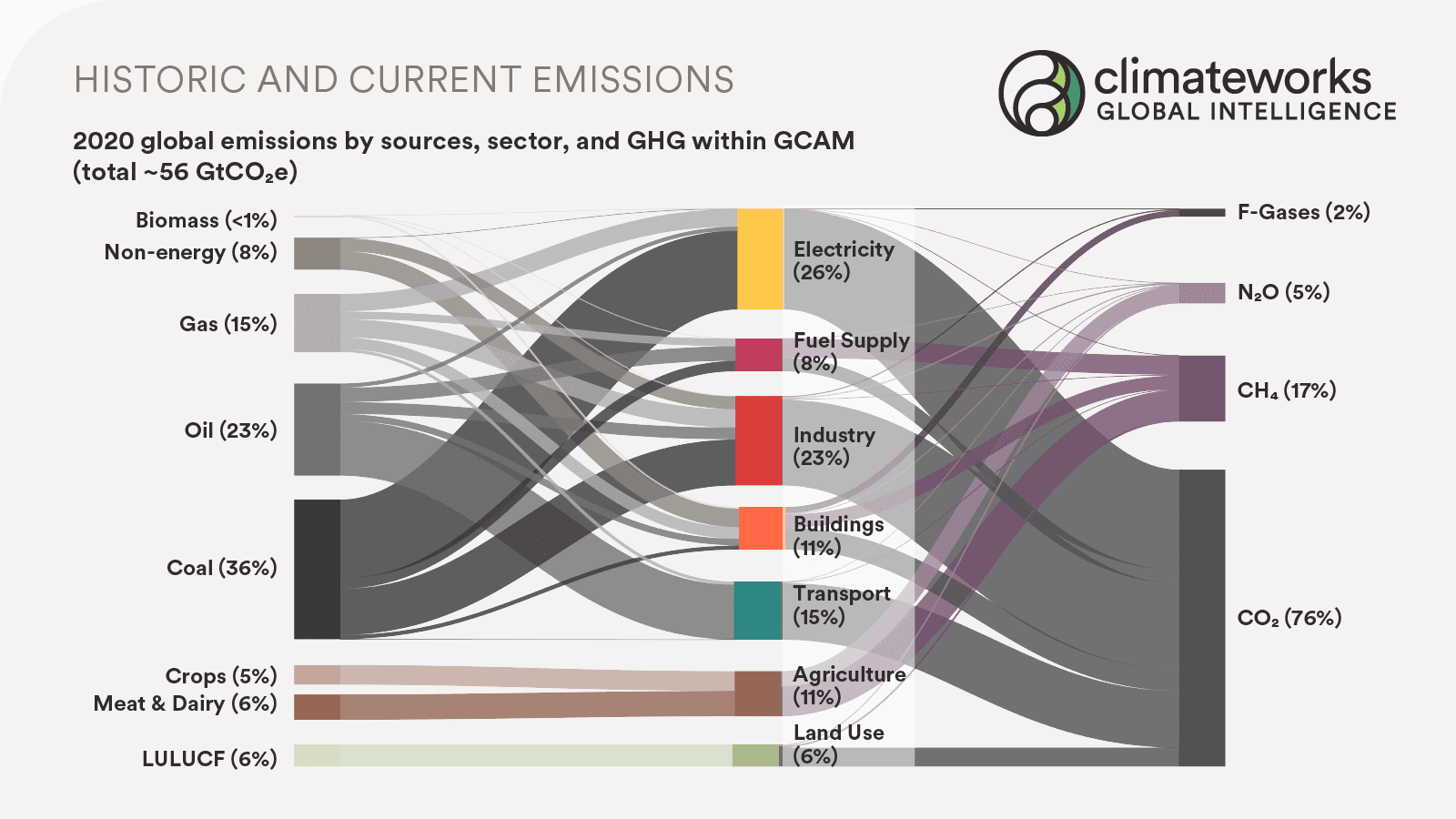
Covering all greenhouse gases and myriad mitigation opportunities by sector and geography, Achieving global climate goals by 2050: Pathways to a 1.5° C future, answers “what-if” questions to reveal a nuanced story about the linkages and trade-offs inherent in climate action. This updated climate modeling report, based on open-source data, is an essential analytical tool for funders and anyone advancing climate solutions and is a follow-up to an inaugural report published in 2020.
In 2015, countries around the world adopted the landmark Paris Agreement on climate change, with the goal to limit global temperature rise to below 1.5° C relative to pre-industrial levels. Research consistently suggests that this will require halving global greenhouse gas (GHG) emissions by 2030 and reaching net-zero CO₂ emissions by 2050 — targets that necessitate rapid, transformative action on a global level.
There has been important progress since the signing of that landmark pact, but the world remains off track from meeting critical climate milestones. In our work with the philanthropy and climate solutions communities, we field many “what-if” questions: How can investing in one climate solution create benefits that help to accelerate progress across multiple sectors or geographies? How will emerging technologies — or the lack thereof — impact our ability to meet 2050 net-zero goals?
To answer these “what-if” questions, we partnered with leading climate researchers at the Pacific Northwest National Laboratory (PNNL) to model the linkages and trade-offs of climate investments. This research underpins the climate strategies we co-create with our funders and grantees. We are excited to make it available as a resource for the broader climate solutions community as we work collectively to advance transformational climate action.
The report provides readers with an overview of the solution space for climate change mitigation. It serves as a portfolio analysis tool to help funders and the broader climate solutions community understand how emissions reduction opportunities are distributed across sectors and geographies — and the transformations needed to achieve 1.5° C targets.
For those interested in engaging on a more technical level, we have made the report’s underlying data freely available to allow for a more detailed and informative discussion on how a 1.5° C pathway might be achieved.
Mitigation opportunities by sector and geography
“Achieving global climate goals by 2050” identifies priorities for emissions reductions across 10 geographies within electricity, fuel supply, transport, buildings, industry, land use, agriculture, and carbon dioxide removal. This report uses a range of climate scenarios developed with the open-source Global Change Assessment Model (GCAM) and designed in partnership with PNNL and program experts at ClimateWorks Foundation. The report provides detailed information on how deep transformations across various sectors can help put the world on a path to a climate-safe future.
Figure 1 indicates significant annual emissions reductions by 2050 — about 70 gigatons of carbon dioxide emitted (GtCO₂e) according to the Central scenario and a range of 61 to 70 GtCO₂e according to the Ensemble scenario — in line with what is needed to limit temperature rise to 1.5° C.

The report also highlights the countries and regions where emissions reductions can take place, with nearly 80% of emissions reductions needed by 2050 being possible in China, India, the United States and Canada, Europe, Africa, Southeast Asia, and Brazil.
New for 2023: An Ensemble of scenarios and open-source data access
For the first time, this report highlights an Ensemble of scenarios that considers a balance of approaches and reveals additional nuance, linkages, and trade-offs inherent in any climate change mitigation strategy. Specifically, the Ensemble focuses on the pace and deployment of six key parameters: bioenergy, carbon capture and sequestration, carbon dioxide removal, electrification for road transportation, nuclear generation, and renewable energy generation.
This Ensemble of scenarios can help answer a variety of “what-if” questions about the use of different technologies or the pace of deployment. In other words, as part of refining a broader climate strategy, readers can reference the Ensemble to help determine the various potential trade-offs of prioritizing certain sectors or interventions over others — and the pathway implications of such choices on achieving 1.5° C targets by 2050.
Additionally, we made the report’s data freely available so the climate research community can use the tools we developed in partnership with PNNL to track the distribution of global emissions by source, sector, and end-use (see Figure 2 for example). The datasets are available for download on the ClimateWorks website.

How to develop a well-informed climate change mitigation strategy
Currently, the world is falling behind on efforts to meet the Paris Agreement’s primary goal to limit global temperature rise to below 1.5° C — a target that will require achieving net-zero CO₂ emissions by midcentury. The climate solutions community can use the findings highlighted in “Achieving global climate goals by 2050: Pathways to a 1.5° C future” to consider the broader landscape of opportunities for emissions reductions across sectors and geographies — as well as the interdependencies and trade-offs between them.
Read the full report, Achieving global climate goals by 2050: Pathways to a 1.5° C future.
Contact ClimateWorks to learn more about climate change mitigation opportunities, how to develop a climate strategy, or how we model our scenarios.


